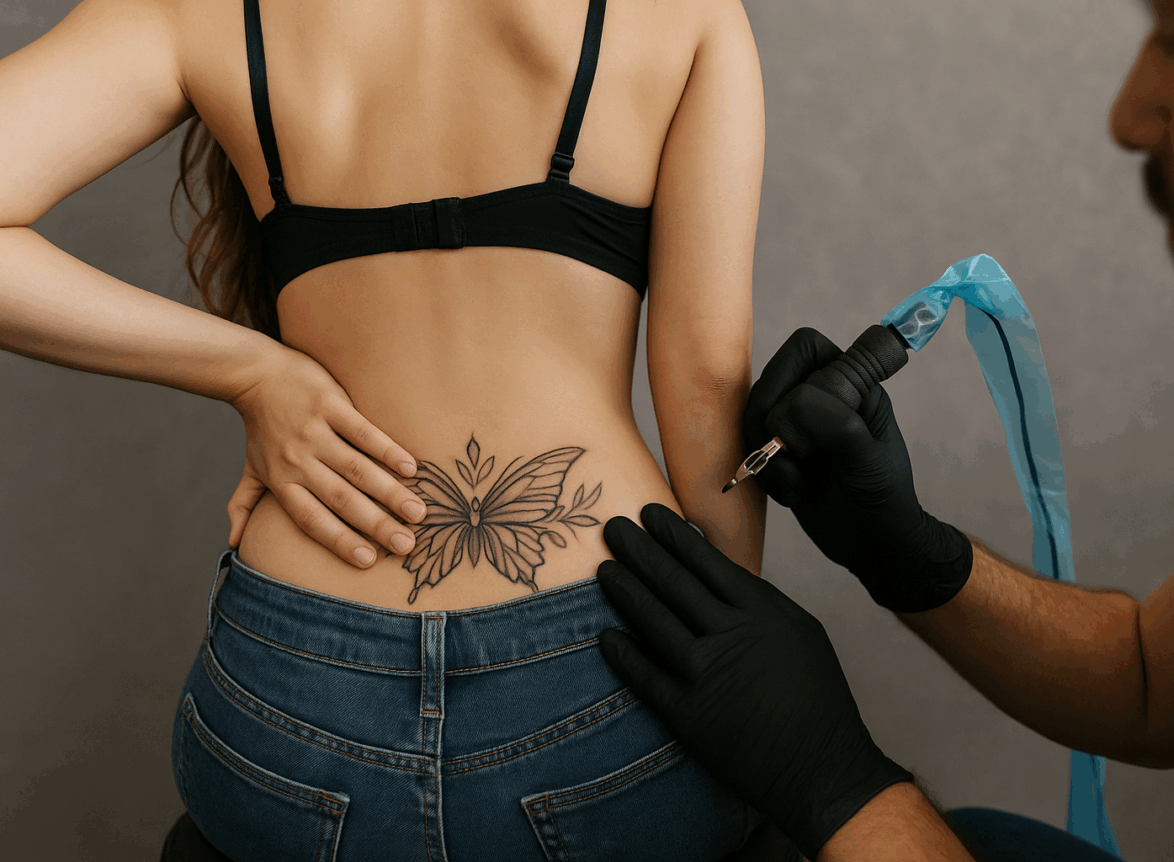The lower back tattoo has been many things over the years—worshipped, mocked, misunderstood, reclaimed. But no matter the nickname (hello, “tramp stamp”), it remains one of the most sensual, symmetrical, and artistically versatile tattoo placements on the body. If you’re thinking about getting inked on your lower back, you’re not just choosing a location—you’re choosing a canvas with powerful potential and a history all its own.
But this area also comes with unique factors you need to consider: from pain level and healing challenges to design flow, symbolism, social perception, and long-term body changes.
This guide breaks down everything you need to know before committing to a lower back tattoo—so your decision isn’t just beautiful, but smart, safe, and confidently yours.
📍Why the Lower Back Is a Prime Spot for Tattoos
Let’s start with why the lower back still holds strong tattoo appeal, even after years of cultural commentary:
- Flat, wide space: The lower back provides a symmetrical, flat surface that makes it ideal for complex, flowing designs.
- Discreet yet revealable: You can hide it under clothes or show it off with crop tops, bikinis, or lingerie.
- Central alignment: It’s one of the few placements that sits dead center on your body, which looks visually powerful and balanced.
- Low movement: Unlike arms or ribs, the skin on the lower back doesn’t stretch or contract as much during daily activity, which helps with design longevity.
🧠 The Cultural History of the Lower Back Tattoo
In the early 2000s, the “tramp stamp” label attached to lower back tattoos carried major judgment—especially toward women. But the truth is, lower back tattoos have existed long before that nickname took hold, and their value isn’t tied to pop culture soundbites.
🔹 Ancient roots
In some Indigenous and Polynesian cultures, the lower back was used for sacred or protective markings. The area near the spine was often viewed as energetically significant.
🔹 Y2K stigma
Western media and Hollywood of the late ’90s and early 2000s portrayed lower back tattoos as sexually suggestive, even trashy. What was once considered empowering body art became the butt of jokes on sitcoms and talk shows.
🔹 Reclamation
Today, a new wave of tattoo lovers are reclaiming the lower back as a feminine power zone, a sexy canvas, and a symbol of choice and body autonomy. The label “tramp stamp” is being rejected—and replaced with more prideful language around self-expression.
🎨 Best Design Styles for the Lower Back
Because the lower back is so symmetrical and stable, it suits designs that flow outward from the spine, anchor at the center, or wrap around the torso.
🔥 Popular Lower Back Tattoo Ideas:
1. Mandala or Sacred Geometry
Perfect for a centered look that flows out like a sunburst or flower. Visually calming and spiritually charged.
2. Phoenix Rising
Dynamic and empowering. The tail feathers can arc downward while wings fan outward along the waist.
3. Wings or Angelic Symbology
Great for symmetry—each wing can flow toward the hip, giving a heavenly or rebellious look depending on style.
4. Script or Typography
Centered quotes or names can look powerful. Choose fonts that curve with your back’s shape rather than fighting it.
5. Cherry Blossoms or Floral Vines
These look gorgeous trailing from the center spine outward or upward. Feminine, graceful, and timeless.
6. Tribal or Ornamental Work
Still popular for those who want bold, graphic impact. Make sure your artist specializes in this style so it flows properly with your anatomy.
🤕 Pain Level: What to Expect
The lower back isn’t the worst place for tattoo pain—but it’s also no walk in the park.
🔹 Moderate to High Pain (Depending on the Spot)
- Over the spine or sacrum = sharper, nerve-heavy pain
- Closer to the love handles or hips = more tolerable, fleshy
- Upper tailbone area = sensitive, especially near the top of your glutes
Some describe the sensation as a deep scratch, others as a burning ache. You may feel pressure resonate into your legs or hips, especially during longer sessions.
Tip: Bring a pillow or support if you’ll be lying on your stomach. The positioning for this tattoo can make the pain worse if your back arches for too long.
🪞 Body Changes and Long-Term Considerations
Because the lower back is part of your core and waistline, it’s affected by weight changes, pregnancy, and posture.
🔹 Skin Stretching
Gaining or losing weight can subtly alter your tattoo’s shape. Big fluctuations might distort finer linework or symmetry.
🔹 Pregnancy
During pregnancy, the abdomen expands—but some women experience lower back tension or changes in posture. A lower back tattoo won’t stretch as much as a stomach tattoo, but hormonal shifts and posture changes can affect how it sits or feels.
Important: Some anesthesiologists may hesitate to perform an epidural through a tattooed lower back—though many now agree it’s generally safe. Still, it’s worth noting if you’re planning a pregnancy down the line.
🧼 Healing Tips for the Lower Back
This area isn’t hard to heal—but it is awkward to reach, and it can be irritated by clothing or movement.
✅ Do:
- Have someone help you apply ointment or film during early healing
- Wear loose, low-rise pants to avoid waistband friction
- Sleep on your side or stomach if you can, especially the first 3–5 days
- Keep it clean and dry—no soaking, just gentle washing
❌ Don’t:
- Sit for long hours in tight jeans during early healing
- Wear rough waistbands or thick belts over the tattoo
- Let sweat build up under layers—moisture can slow healing or cause infection
🙅♀️ Should You Worry About the “Tramp Stamp” Stereotype?
Short answer: Only if you let it define you.
The phrase “tramp stamp” has been used to shame women for owning their sexuality, showing skin, or simply liking symmetrical tattoos. But here’s the truth:
- The design you choose reflects your taste, not pop culture punchlines
- Tattoos don’t make people trashy—judgment does
- Lower back tattoos are beautiful, sensual, and powerful when chosen with intent
If anyone mocks your lower back tattoo in 2025? That says more about them than it does about you.
💡 Is It Right for You?
Here’s a checklist to help you decide if a lower back tattoo is the right call for your body, goals, and lifestyle:
- ✅ I want a tattoo that’s easy to hide but powerful when shown
- ✅ I’m into symmetry, flowing lines, or centered designs
- ✅ I’m okay with some awkward positioning during the session
- ✅ I can commit to healing without irritating it daily
- ✅ I want something that feels feminine, strong, or sexy for me, not for the male gaze
If you’re checking all the boxes, the lower back could be one of the best placements for your next piece.
🙋 FAQ: Lower Back Tattoos
Q: Will it stretch or sag as I age?
A: Possibly, but most lower back tattoos hold up well over time since the skin doesn’t move as much day-to-day. Keeping your core strong and staying hydrated helps.
Q: Can I wear a waist trainer or tight pants while it heals?
A: Not in the first 7–10 days. You need the area to breathe. Once healed, you’re good to wear what you like.
Q: Is it only for women?
A: Not at all. Men are also reclaiming the lower back for ornamental tattoos, tribal pieces, and even full-wrap work that blends with side panels or hip designs.
Q: Can it be part of a bigger piece?
A: Yes! It can anchor a full back piece, connect to hip tattoos, or act as the centerpiece in a front-to-back wraparound.
✨ Final Thoughts: Make It Yours
Lower back tattoos have been judged unfairly for far too long. But in reality, they’re one of the most powerful placements you can choose—for their symbolism, symmetry, secrecy, and sex appeal.
Whether you want something floral, fierce, spiritual, or seductive, this placement gives you space to make it bold, soft, or sacred.
The key is choosing:
- A design with meaning and flow
- An artist who understands symmetry and movement
- Aftercare that protects your investment
- Confidence that says: this is for me—not for anyone else’s label
So if you’re ready to reclaim the lower back—go for it.
Get the ink. Rock the crop top.
Let your art speak louder than outdated words ever could.

